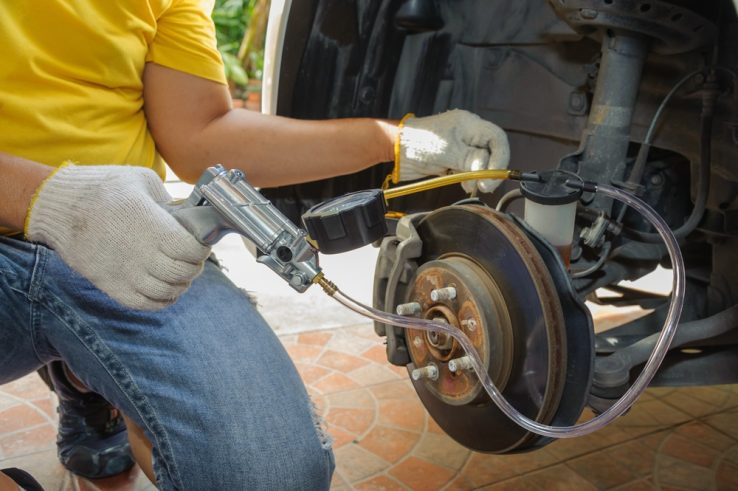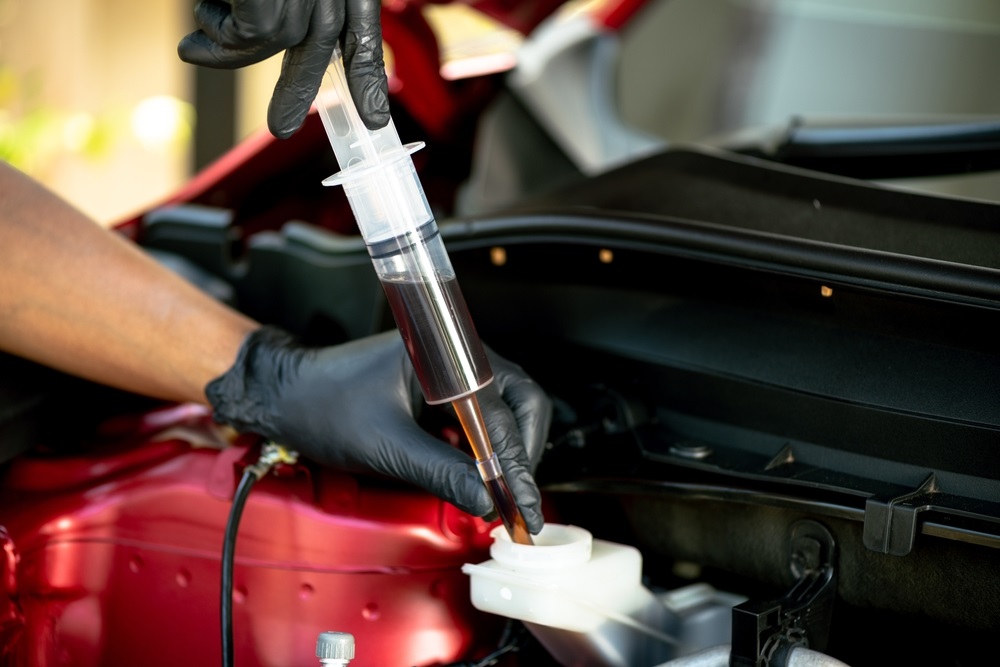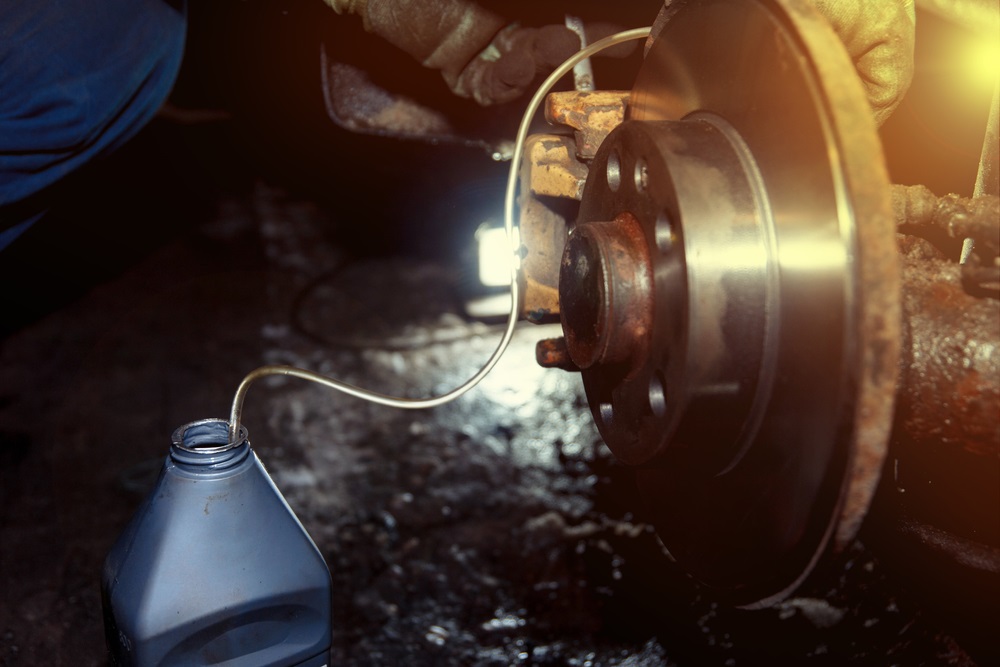Regular brake fluid maintenance is key to keeping your vehicle’s brake system in top condition. Over time, brake fluid can become contaminated with moisture, dirt, and air, which can severely impact braking performance. In this guide, EZ-Brakes will walk you through how to flush brake fluid, including how to flush brake fluid lines and other methods to maintain your vehicle’s braking efficiency.
By following this step-by-step process, you can ensure your vehicle’s brake system remains responsive and safe for the road. Whether you’re wondering how to flush brake fluid yourself or looking for brake professional help with a brake fluid flush near you, we’ve got you covered.
What’s a Brake Fluid Flush?
A brake fluid flush is a maintenance process where the old, degraded brake fluid is completely drained from your vehicle’s brake system and replaced with new fluid. Brake fluid plays a critical role in transferring the force from your brake pedal to the brake calipers, allowing your car to stop efficiently. Over time, this fluid becomes contaminated with moisture and debris, which can lead to reduced braking performance, corrosion of internal components, and even brake failure.
At EZ-Brakes, we emphasize the importance of regular brake fluid flushes as part of routine vehicle care. By flushing out the old fluid and replenishing it with the correct type of fresh brake fluid, you ensure the brake system remains responsive and reliable. Whether you’re learning how to flush brake fluid yourself or searching for a brake fluid flush near me, keeping this part of your vehicle’s system in top shape is essential for safe driving.
Why Is Flushing Brake Fluid Important?
Flushing brake fluid is critical for ensuring the optimal performance of your braking system. Brake fluid absorbs moisture over time, which can lower the boiling point of the fluid and lead to brake failure under high-stress conditions. Moisture can also cause corrosion in your brake lines and master cylinder, making it essential to replace the fluid periodically.
Here’s why flushing brake fluid regularly is crucial:
• Prevent Moisture Build-up: Moisture reduces braking power and can corrode brake components.
• Maintain Braking Performance: Regular fluid flushing ensures efficient brake function.
• Enhance Safety: Proper brake fluid levels and quality reduce the risk of brake failure.
Signs It’s Time to Flush Your Brake Fluid
There are several indicators that your brake fluid needs to be flushed. Knowing the signs can help prevent costly repairs and ensure your car’s braking system remains safe and functional.
• Spongy or Soft Brake Pedal: A spongy pedal can be caused by air bubbles or moisture in the brake fluid. If you notice this, it’s time to check the fluid.
• Reduced Braking Performance: If your vehicle takes longer to stop or you feel less responsiveness, your brake fluid may be degraded.
• Discolored Fluid: Fresh brake fluid is clear or light amber, while old fluid becomes dark and murky. This discoloration is a sign that the fluid needs replacement.
• Brake Warning Light: If the brake warning light comes on, it’s essential to check the fluid levels and consider flushing the brake fluid lines.
Read More: Why Are My Brakes Squeaking?
How to Flush Brake Fluid – Step-by-Step Guide
Flushing brake fluid yourself is a straightforward process, but it requires attention to detail. Here’s how to flush brake fluid lines and perform the task safely.
Tools and Materials You’ll Need
• Brake Fluid (DOT 3, DOT 4, DOT 5, or as specified for your vehicle)
• Brake Bleeder Tool or Wrench
• Clear Container for Old Fluid
• Assistant (if needed for pedal pumping)
• Gloves and Safety Glasses
How to Flush Brake Fluid Lines
- Prepare the Vehicle: Ensure your vehicle is on a flat surface, and the engine is off. Open the hood and locate the brake fluid reservoir.
- Check the Fluid Level: Before starting, ensure the fluid level is sufficient. Low brake fluid may indicate leaks or a problem with the braking system.
- Loosen the Bleeder Valve: If you’re doing it yourself, you may need a helper to pump the brake pedal while you open and close the bleeder valve to release the old fluid. The valve is usually located on the brake calipers.
- Flush the Old Fluid: Begin with the brake farthest from the master cylinder (usually the passenger side rear) and work your way toward the closest (driver side front).
- Refill with New Fluid: As old fluid is released, ensure the brake fluid reservoir is kept topped off with fresh fluid. This prevents air from entering the brake lines.
- Repeat for All Brake Lines: Perform the same process for each wheel, ensuring that all lines are flushed.
How to Flush Brake Fluid Without Bleeding
In some cases, you may want to flush brake fluid without bleeding the system. This is particularly useful if you’re dealing with a sealed brake system or want to save time. Here’s how to flush brake fluid without bleeding:
- Use a Vacuum Pump or Pressure Kit: These tools help evacuate the old fluid from the brake lines without requiring the brake pedal to be pumped.
- Follow the Same Steps for Fluid Replacement: Once the old fluid is extracted, refill with fresh brake fluid, ensuring the system is sealed and air-free.
This method can save you time and eliminate the need for a helper.
How Often to Change Brake Fluid – Tips for Regular Maintenance
Understanding when to change your brake fluid is essential for maintaining a safe driving experience. The general recommendation is to flush brake fluid every two years or around 24,000 miles. However, factors such as driving conditions and the type of vehicle may require more frequent maintenance.
• Monitor Fluid Condition: Even if you don’t reach the 2-year mark, keep an eye on the fluid’s color and consistency. If the fluid is dark or discolored, it’s time for a change.
Common Mistakes to Avoid When Flushing Brake Fluid
To ensure your brake fluid flush is done correctly, avoid these common mistakes:
• Over-tightening the Bleeder Valve: Be gentle when closing the valve to prevent damage to the brake components.
• Not Monitoring Fluid Levels: Always keep the brake fluid reservoir topped up to avoid introducing air into the brake lines.
• Using the Wrong Brake Fluid: Make sure you use the correct fluid type for your vehicle (DOT 3, DOT 4, DOT 5). Using the wrong type can cause damage.
• Skipping the Flush Entirely: Neglecting regular brake fluid flushes can lead to decreased braking efficiency and costly repairs.
Finding a Brake Fluid Flush In Orange County, CA– Professional Service
If you don’t feel comfortable flushing your brake fluid yourself or simply prefer a professional service, searching for a “brake fluid flush near me” can help you find reliable local mechanics. EZ-Brakes as a mobile brake service offers comprehensive brake fluid flushing services to ensure your system remains in optimal condition.
Professional technicians can perform a thorough brake fluid flush, ensuring the brake lines are fully purged of old fluid and contaminants. It’s a great option for those who want the peace of mind that comes with professional service.
Our Service Areas
At EZ-Brakes, we proudly offer expert mobile brake repair and service across a wide range of communities in Southern California. Our team is committed to providing top-notch service to drivers across various locations, ensuring your vehicle is in safe hands. We serve the following areas:
• Brake Service Costa Mesa
• Brake Service Laguna Hills
• Brake Service Mission Viejo
• Brake Service Lake Forest, CA
• Brake Service Rancho Santa Margarita
• Brake Service Laguna Beach
• Brake Service Irvine
• Brake Service Anaheim
• Brake Service Corona Del Mar
• Brake Service Laguna Niguel
• Brake Service San Juan Capistrano
Wherever you are, EZ-Brakes is ready to deliver reliable, efficient brake services right to your neighborhood!
FAQ About
HOW DO I KNOW IF MY BRAKE FLUID NEEDS TO BE FLUSHED?
If you notice a spongy brake pedal, reduced braking performance, discolored fluid, or see the brake warning light on your dashboard, it’s time to flush your brake fluid. Regular maintenance can prevent these issues and keep your braking system working efficiently.
HOW OFTEN SHOULD I FLUSH MY BRAKE FLUID?
It’s typically recommended to flush brake fluid every 2 years or 24,000 miles, though driving conditions can affect the frequency. For motorcycles, brake fluid should be flushed at least once a year.
CAN I FLUSH MY BRAKE FLUID MYSELF?
Yes, you can flush brake fluid yourself with the right tools and instructions. However, if you’re unsure or uncomfortable with the process, consider seeking help from a professional mechanic.
HOW CAN I FLUSH BRAKE FLUID WITHOUT BLEEDING?
To flush brake fluid without bleeding, use a vacuum pump or pressure kit to evacuate the old fluid from the brake lines. This method is faster and eliminates the need for a helper to pump the brake pedal.
WHERE CAN I FIND A BRAKE FLUID FLUSH NEAR ME?
You can search for a “brake fluid flush near me” to find local service providers. EZ-Brakes offers professional brake fluid flushing services to ensure your vehicle’s brake system stays in top shape.
Conclusion
Flushing brake fluid is an essential part of vehicle maintenance. Whether you’re doing it yourself or choosing a professional service like EZ-Brakes, regular brake fluid flushing helps maintain braking performance, prevent costly repairs, and ensure the safety of your vehicle. By following this guide, you can ensure your brakes stay in optimal condition for years to come.




